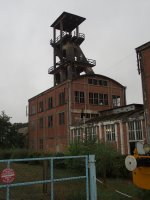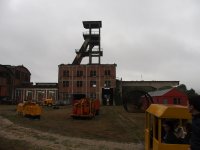Part 1 Silesa, Poland can be found Here
These were all taken on a drive around Europe in October last year. I did get photos of a couple more but they were not very good so are not included here.
FRANCE
Marles-les-Mines - Headframe of Marles pit no 2. The headframe operated from 1921-1973, there is small museum on the site but I didn't have time to visit.

La Base. Shaft 11 was Sunk in 1891 and the mine closed in 1986. Saw this by chance when driving down the main road.

Shaft 9 + 9b, Oignies. Twin shafts which bought up over 4.8 million tonnes of coal in 60 years. The buildings are now used for other purposes, including a music hall.



Escarpelle mine headframe, now sat as a centre piece in an industrial estate.

Mining history centre at Lewarde. This was a working colliery from 1927-1971. There is some interesting pieces in the museum.

The heapstead and third shaft.

Arenberg. Coal production started in 1903 until 1989. The shaft with the A frame dates from 1954, and the others from 1903, however the headframes are likely newer. The pie was named after the manager of the mining company.


Sabatier Mine. Worked from 1910 until 1980, it was operated by the same company as Arenburg.

LeDoux colliery - Another mine owned by the Anzin mining company and named after one of the senior officials. Very little remains of this site, just the headframe in a field and an outlet for methane. Coal production started in 1905 and continued until 1988. This is shaft no 1 and was 759 metre deep. French wikipedia link

Wendel mine. Mining started out at the Wendel mine in the mid-late 1800s. It's located right on the France/German so over the years it's changed hands a few times and currently resides in france. It's the most complete mining site on this list and is now a museum. There is 4 headframes on the site, one of which is clearly seperate to the the rest. The pit closed in stages from 1989 until final closure in 2001.


These were all taken on a drive around Europe in October last year. I did get photos of a couple more but they were not very good so are not included here.
FRANCE
Marles-les-Mines - Headframe of Marles pit no 2. The headframe operated from 1921-1973, there is small museum on the site but I didn't have time to visit.

La Base. Shaft 11 was Sunk in 1891 and the mine closed in 1986. Saw this by chance when driving down the main road.

Shaft 9 + 9b, Oignies. Twin shafts which bought up over 4.8 million tonnes of coal in 60 years. The buildings are now used for other purposes, including a music hall.



Escarpelle mine headframe, now sat as a centre piece in an industrial estate.

Mining history centre at Lewarde. This was a working colliery from 1927-1971. There is some interesting pieces in the museum.

The heapstead and third shaft.

Arenberg. Coal production started in 1903 until 1989. The shaft with the A frame dates from 1954, and the others from 1903, however the headframes are likely newer. The pie was named after the manager of the mining company.


Sabatier Mine. Worked from 1910 until 1980, it was operated by the same company as Arenburg.

LeDoux colliery - Another mine owned by the Anzin mining company and named after one of the senior officials. Very little remains of this site, just the headframe in a field and an outlet for methane. Coal production started in 1905 and continued until 1988. This is shaft no 1 and was 759 metre deep. French wikipedia link

Wendel mine. Mining started out at the Wendel mine in the mid-late 1800s. It's located right on the France/German so over the years it's changed hands a few times and currently resides in france. It's the most complete mining site on this list and is now a museum. There is 4 headframes on the site, one of which is clearly seperate to the the rest. The pit closed in stages from 1989 until final closure in 2001.


Last edited:
































